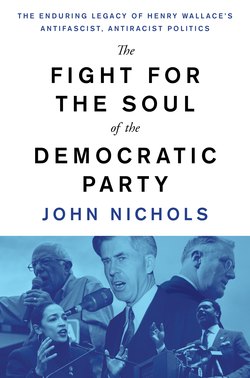Читать книгу The Fight for the Soul of the Democratic Party - John Nichols - Страница 11
На сайте Литреса книга снята с продажи.
Оглавление4
The Fight against American Fascism
Henry Wallace and the Consequencesof Speaking Truth to Power
The American fascist would prefer not to use violence. His method is to poison the channels of public information. With a fascist the problem is never how best to present the truth to the public but how best to use the news to deceive the public into giving the fascist and his group more money or more power.
—Henry Wallace, New York Times, April 9, 1944
I know personally from experience that there is a certain zone which when a man has walked through it, he has got to be careful. Maybe Time was the scissors that Delilah used for shearing Samson! After which, “Samson wist not that God had departed him!” I am afraid—deeply and mortally afraid—because I love my country and want it to go right, that I can hear Delilah’s scissors clicking.
—William Allen White to Henry Wallace, August 10, 1943
Amid all the perfervid debate about whether Trump or Trumpism was ushering in homegrown fascism during the first year of the 45th presidency, a social-media meme started making the rounds. It purported to quote Henry Wallace defining an American fascist as “one whose lust for money or power is combined with such an intensity of intolerance toward those of other races, parties, classes, religions, cultures, regions or nations as to make him ruthless in his use of deceit or violence to attain his ends.” That read like too perfect a prediction of Trump and Trumpism. People were skeptical, as they often are of online memes. The fact-checking website Snopes.com took up the question: “Did FDR’s Vice-President Write an Op-Ed About ‘American Fascism’?” The website recognized why people would doubt that a sitting vice president might have made so bold a statement. But Snopes certified that the quote had been “correctly attributed.”
It is a measure of how time and bias unwind our history that Wallace’s engagement with the threat of American fascism was forgotten. Seventy-five years earlier, however, what Wallace was doing went to the very heart of the struggle for the soul of the Democratic Party and the country. For the better part of a year, from the summer of 1943 to the summer of 1944, everyone who was paying attention knew that Wallace was defining fascism in an American context, as he wrote in the New York Times: “Every Jew-baiter, every Catholic hater, is a fascist at heart. The hoodlums who have been desecrating churches, cathedrals and synagogues in some of our larger cities are ripe material for fascist leadership.” They knew that, even as American leaders denounced the crimes of German and Italian fascists, the vice president was charging that the United States harbored millions of “patriotic Americans” who were “willing at all times to engage in any degree of deceit and violence necessary to place his culture and race astride the world.”
Wallace was expanding the definition of American fascism. He was not just talking about Fritz Julius Kuhn’s Nazi-inspired German American Bund and the Fascist League of North America that Mussolini’s agent, Paolo Ignazio Maria Thaon di Revel, had organized in New York and Boston. This was about more than the fear that there lingered in the United States remnants of the crowds that packed arenas for the Bund’s prewar rallies, like the 1939 “Mass Demonstration for True Americanism” that filled Madison Square Garden with 20,000 self-identified “American patriots” who mingled chants of “Sieg Heil!” with the recitation of the Pledge of Allegiance, cheered speakers who mocked the Roosevelt administration’s “Jew Deal” and unfurled banners that read “Wake Up America. Smash Jewish Communism.” This was about more than the incidents like those in which young men dressed in the SS-inspired uniforms of the American Ordnungsdienst marched into Milwaukee public meetings and beat up anyone who dared to object when the jagged thunderbolt symbol of the SS was raised beside the stars and stripes. About more than the assassination in January 1943 of the antifascist campaigner Carlo Tresca, which took place at the corner of Fifth Avenue at 15th Street in New York City.
“The dangerous American fascist is the man who wants to do in the United States in an American way what Hitler did in Germany in a Prussian way,” argued Wallace in his landmark essay “The Danger of American Fascism,” published in the New York Times Sunday magazine on April 9, 1944. He charged that those who sought to divide the United States along lines of race, religion and class could be “encountered in Wall Street, Main Street or Tobacco Road.”
“Some even suspect,” Wallace wrote, “that they can detect incipient traces of it along the Potomac.”
That was a politically risky line for a candidate for re-election, especially at a time when the New Deal Coalition included a Southern contingent that defended segregation and threatened to withhold support for initiatives that challenged racism. The Southerners, and the Northern business interests that often aligned with them, were not going to appreciate it when a Democratic vice president said, “It may be shocking to some people in this country to realize that, without meaning to do so, they hold views in common with Hitler when they preach discrimination against other religious, racial or economic groups.”
